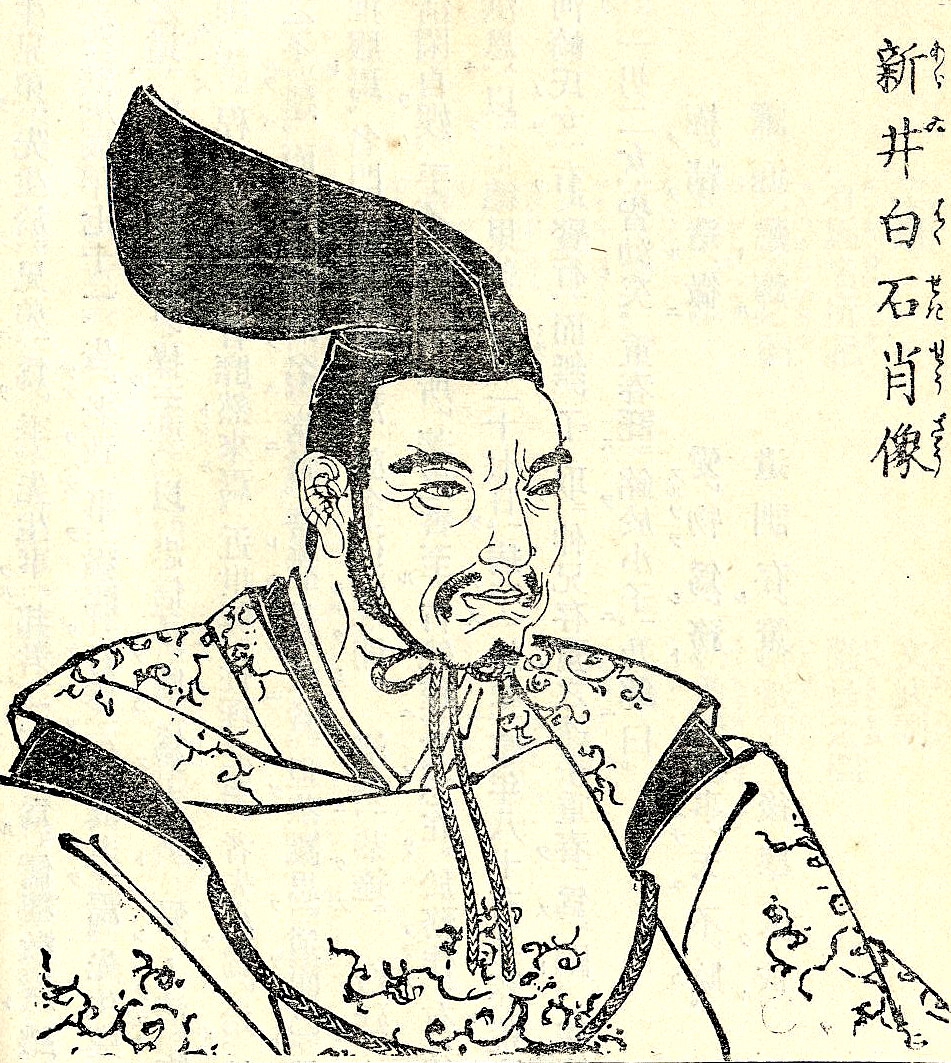- Arai Hakuseki
Infobox Writer
name = Arai Hakuseki

imagesize = 200px
caption = Japanese book 『先哲像伝』
pseudonym =
birthdate = March 24, 1657
birthplace = Edo
deathdate = June 29, 17
deathplace = Edo
occupation = Neo-Confucian scholar, academic, administrator, writer
nationality =
period =
genre =
subject = Japanese history, literature
movement =
spouse =
partner =
children =
relatives =
influences =
influenced =
website = nihongo|Arai Hakuseki|新井白石|extra=March 24 ,1657 -June 29 ,1725 was aConfucianist ,scholar ,academic ,administrator ,writer andpolitician in Japan during the middle ofEdo Period , who advised theShogun Tokugawa Ienobu . [Screech, Timon. (2006). "Secret Memoirs of the Shoguns: Isaac Titsingh and Japan, 1779-1822," pp.65-66.] His personal name is Kinmi (君美). Hakuseki (白石) was his pen name. His father was a Kururi han samurai "Arai Masazumi" (新井 正済).Biography
Hakuseki was born in
Edo and from a very early age displayed signs ofgenius . According to one story, at the age of three Hakuseki managed to copy a Confucian book written inKanji , character by character. Because he was born on the same year as theGreat Fire of Meireki and because he was hot tempered and his brow would crease looking like 火 or "fire", he was affectionately called "Hi no Ko" (火の子) or "child of fire". He was a retainer ofHotta Masatoshi , but after Masatoshi was assassinated byInaba Masayasu , theHotta clan was forced to move from Sakura toYamagata then toFukushima and the domain's income declined. Hakuseki offered to leave, becoming aronin and studied under Confucianist Kinoshita Jun'an. He was offered a post by the largest "han", that ofKaga Domain , but he offered the position to a fellow samurai.In 1693, Hakuseki was called up to serve by the side of
Manabe Akifusa as a "brain" for theTokugawa shogunate and shogunTokugawa Ienobu . He went on to displace the official Hayashi advisers to become the leading confucianist for Ienobu andTokugawa Ietsugu . While some of Hakuseki's policies were still carried out after Ienobu's death, after the 6th shogun, Tokugawa Ietsugu, died andTokugawa Yoshimune 's rule began, Hakuseki left his post to begin his career as a prolific writer of Japanese history and Occidental studies.He was buried in
Asakusa (current dayTaito, Tokyo ), Ho'onji temple but was later moved toNakano, Tokyo ,Kotokuji temple.Economic Policy
Under the top
Rōjū ,Abe Seikyo , with strong support from Ienobu, he launchedShotoku no Chi , a series of economic policies designed to improve the shogunate's standing. By minting new and better quality currency, inflation was controlled. Calculating from trade records, Hakuseki deduced that fully 75% of gold and 25% of silver in Japan had been spent on trades with foreign countries. Concerned that Japan's national resources were at risk, he implemented a new trade policy, the "Kaihaku Tagae-ichi Shinrei"(海舶互市新例), to control payments to Chinese and Dutch merchants by demanding that instead of precious metals, products like silk, porcelain, and dried seafoods should be used for trading. However, the beneficial effects of this policy were limited as the trade of precious metals from Tsushima and Satsuma was uncontrolled by the "bakufu ".He also simplified rituals for welcoming the
Joseon Dynasty 's ambassadors, in the face of opposition from the Tsushima ConfucianistAmamori Hoshu .Constitutional policy
Hakuseki applied the
mandate of heaven to both theemperor and theshogun . Since there had been no revolution to change Japan's basic institutions, he argued that the shogun was subordinate to the emperor and that in showing good governance, moral fortitude and respect to the emperor a shogun proved that he helddivine right . He also traced Tokugawa family roots back to theMinamoto clan and thus to a line of imperial descent in order to show that Ieyasu's political supremacy had been fitting. To strengthen the shogun's power and maintain national prestige he proposed changing the title to koku-o - nation-king.Written works
His works include:
* "Hankanfu " (藩翰譜). A list of daimyo's family tree
* "Koshitsu " (古史通). A work that detailed ancient history of Japan
* "Oritaku Shiba-no-ki " (折りたく柴の記). A diary andmemoir * 1709 -- nihongo|"
Sairan Igen "|采覧異言,|"Collected views and strange words".Screech, p. 66.]
* 1711 -- nihongo|"Hōka shiryaku"| |"Brief history of currency", also known as "Honchō hōka tsūyō jiryaku" ("Short Account of the circulation of currency in this realm"). [Screech, p. 65.]
** _________. 1828). "Fookoua Siriak: traité sur l'origins des richesses au japon" (translation of "Hōka shiryaku" by Julius Klaproth). Paris. fr (1712). '
* 1712 -- nihongo|"Tokushi Yoron "|読史余論,|"Lessons from History". [see above] ]
* 1715 -- nihongo|"Seiyō Kibun "|西洋記聞,|"Record of things heard from the West. [see above] ] A work describing the Occident, based on Hakuseki's conversations withGiovanni Battista Sidotti References
*cite book | author=Arai Hakuseki Trans.
Joyce Ackroyd | title=Told Round a Brushwood Fire: The Autobiography of Arai Hakuseki | publisher=Princeton University Press | year=1980 | id=ISBN 0-691-04671-9*cite book | author=Arai Hakuseki Trans. Joyce Ackroyd | title=Lessons from History: The Tokushi Yoron | publisher=University of Queensland Press | year=1982 | id=ISBN 0-7022-1485-X
*cite journal | last=Ackroyd | first=Joyce | title=Correspondence | journal=Monumenta Nipponica | volume=40 | pages=97–106 | date=Spring 1985
* Brownlee, John S. (1997) "Japanese historians and the national myths, 1600-1945: The Age of the Gods and Emperor Jimmu." Vancouver:
University of British Columbia Press . ISBN 0-7748-0644-3 Tokyo:University of Tokyo Press . ISBN 4-13-027031-1
*Brownlee, John S. (1991). "Political Thought in Japanese Historical Writing: From Kojiki (712) to Tokushi Yoron (1712)." Waterloo, Ontario: Wilfrid Laurier University Press. ISBN 0-889-20997-9*cite journal | last=Henderson | first=Dan Fenno | title=Chinese legal studies in early 18th century Japan | journal=Journal of Asian Studies | volume=30 | pages=21–56 | date=1970 | doi=10.2307/2942722
*cite journal | last=Kazui | first=Tashiro | journal=Journal of Japanese Studies | title=Foreign Relations during the Edo Period: Sakoku Reexamined | volume=8 | date=Summer 1982 | pages=283–306 | doi=10.2307/132341
* Screech, Timon. (2006). "Secret Memoirs of the Shoguns: Isaac Titsingh and Japan, 1779-1822." London:RoutledgeCurzon . ISBN 0-700-71720-XExternal links
* East Asia Institute,
University of Cambridge : [http://www.oriental.cam.ac.uk/jbib/edoint6.html Further reading/bibliography]
Wikimedia Foundation. 2010.
